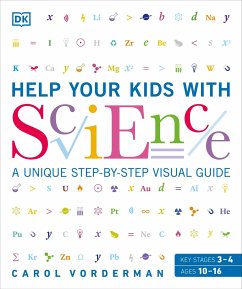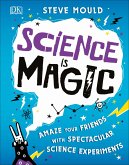Carol Vorderman
Help Your Kids with Science
A Unique Step-by-Step Visual Guide, Revision and Reference
22,99 €
inkl. MwSt.
Versandfertig in 2-4 Wochen

11 °P sammeln
Carol Vorderman
Help Your Kids with Science
A Unique Step-by-Step Visual Guide, Revision and Reference
- Broschiertes Buch
- Merkliste
- Auf die Merkliste
- Bewerten Bewerten
- Teilen
- Produkt teilen
- Produkterinnerung
- Produkterinnerung
Enables you to reduce the stress of studying science and help your children with their homework. This title covers the important areas of biology, chemistry and physics. It includes a glossary of key science terms and symbols.
Andere Kunden interessierten sich auch für
![Help Your Kids with Maths, Ages 10-16 (Key Stages 3-4) Help Your Kids with Maths, Ages 10-16 (Key Stages 3-4)]() Carol VordermanHelp Your Kids with Maths, Ages 10-16 (Key Stages 3-4)17,99 €
Carol VordermanHelp Your Kids with Maths, Ages 10-16 (Key Stages 3-4)17,99 €![Help Your Kids with English, Ages 10-16 (Key Stages 3-4) Help Your Kids with English, Ages 10-16 (Key Stages 3-4)]() Carol VordermanHelp Your Kids with English, Ages 10-16 (Key Stages 3-4)22,99 €
Carol VordermanHelp Your Kids with English, Ages 10-16 (Key Stages 3-4)22,99 €![Ask A Scientist Ask A Scientist]() Robert WinstonAsk A Scientist18,99 €
Robert WinstonAsk A Scientist18,99 €![Science is Magic Science is Magic]() Steve MouldScience is Magic20,99 €
Steve MouldScience is Magic20,99 €![Let's Make Great Projects Let's Make Great Projects]() DKLet's Make Great Projects20,99 €
DKLet's Make Great Projects20,99 €![Help Your Kids with Music, Ages 10-16 (Grades 1-5) Help Your Kids with Music, Ages 10-16 (Grades 1-5)]() Carol VordermanHelp Your Kids with Music, Ages 10-16 (Grades 1-5)16,99 €
Carol VordermanHelp Your Kids with Music, Ages 10-16 (Grades 1-5)16,99 €![DKfindout! Volcanoes DKfindout! Volcanoes]() DKDKfindout! Volcanoes15,99 €
DKDKfindout! Volcanoes15,99 €-
-
-
Enables you to reduce the stress of studying science and help your children with their homework. This title covers the important areas of biology, chemistry and physics. It includes a glossary of key science terms and symbols.
Produktdetails
- Produktdetails
- DK Help Your Kids With
- Verlag: Dorling Kindersley / Penguin Books UK
- Seitenzahl: 256
- Erscheinungstermin: 1. Juni 2012
- Englisch
- Abmessung: 241mm x 200mm x 22mm
- Gewicht: 810g
- ISBN-13: 9781409383468
- ISBN-10: 1409383466
- Artikelnr.: 35081125
- Herstellerkennzeichnung
- Libri GmbH
- Europaallee 1
- 36244 Bad Hersfeld
- gpsr@libri.de
- DK Help Your Kids With
- Verlag: Dorling Kindersley / Penguin Books UK
- Seitenzahl: 256
- Erscheinungstermin: 1. Juni 2012
- Englisch
- Abmessung: 241mm x 200mm x 22mm
- Gewicht: 810g
- ISBN-13: 9781409383468
- ISBN-10: 1409383466
- Artikelnr.: 35081125
- Herstellerkennzeichnung
- Libri GmbH
- Europaallee 1
- 36244 Bad Hersfeld
- gpsr@libri.de
Carol Vorderman, one of Britain's best known and loved TV personalities, feels passionately about the value of education. Carol joined forces with DK in 1999 to become DK's Education Champion and has worked with them to build the bestselling Made Easy Series which includes Maths, English and Science.
- 1: Foreword by Carol Vorderman
- 2: What is science?
- 3: The Scientific Method
- 4: Fields of Science
- 5: Biology
- 1: What is biology?
- 2: Variety of life
- 3: Cell structure
- 4: Cells at work
- 5: Fungi and single-celled life
- 6: Respiration
- 7: Photosynthesis
- 8: Feeding
- 9: Waste materials
- 10: Transport systems
- 11: Movement
- 12: Sensitivity
- 13: Reproduction I
- 14: Reproduction II
- 15: Life cycles
- 16: Hormones
- 17: Disease and immunity
- 18: Animal relationships
- 19: Plants
- 20: Invertebrates
- 21: Fish, amphibians, and reptiles
- 22: Mammals and birds
- 23: Body systems
- 24: Human senses
- 25: Human digestion
- 26: Brain and heart
- 27: Human health
- 28: Human reproduction
- 29: Ecosystems
- 30: Food chains
- 31: Cycles in nature
- 32: Evolution
- 33: Adaptations
- 34: Genetics I
- 35: Genetics II
- 36: Pollution
- 37: Human impact
- 6: Chemistry
- 1: What is chemistry?
- 2: Properties of materials
- 3: States of matter
- 4: Changing states
- 5: Gas laws
- 6: Mixtures
- 7: Separating mixtures
- 8: Elements and atoms
- 9: Compounds and molecules
- 10: Ionic bonding
- 11: Covalent bonding
- 12: Periodic table
- 13: Understanding the periodic table
- 14: Alkali metals and alkali earth metals
- 15: The halogens and noble gases
- 16: Transition metals
- 17: Radioactivity
- 18: Chemical reactions
- 19: Combustion
- 20: Redox reactions
- 21: Energy and reactions
- 22: Rates of reaction
- 23: Catalysts
- 24: Reversible reactions
- 25: Water
- 26: Acids and bases
- 27: Acid reactions
- 28: Electrochemistry
- 29: Lab equipment and techniques
- 30: Refining metals
- 31: Chemical industry
- 32: Carbon and fossil fuels
- 33: Hydrocarbons
- 34: Functional groups
- 35: polymers and plastics
- 7: Physics
- 1: What is physics?
- 2: Inside atoms
- 3: Energy
- 4: Forces and mass
- 5: Stretching and deforming
- 6: Velocity and acceleration
- 7: Gravity
- 8: Newton's law of motion
- 9: Understanding motion
- 10: Pressure
- 11: Machines
- 12: Heat transfer
- 13: Using heat
- 14: Waves
- 15: Electromagnetic waves
- 16: Light
- 17: Optics
- 18: Sound
- 19: Electricity
- 20: Current, voltage, and resistance
- 21: Circuits
- 22: Electronics
- 23: Magnets
- 24: Electric motors
- 25: Electricity generators
- 26: Transformers
- 27: Power generation
- 28: Electricity supplies
- 29: Energy efficiency
- 30: Renewable energy
- 31: The Earth
- 32: Weather
- 33: Astronomy
- 34: The Sun
- 35: The Solar System I
- 36: The Solar System II
- 37: Stars and galaxies
- 38: Origins of the Universe
- 8: Reference - Biology
- 9: Reference - Chemistry
- 10: Reference - Physics
- 11: Glossary
- 12: Index
- 13: Acknowledgements
- 1: Foreword by Carol Vorderman
- 2: What is science?
- 3: The Scientific Method
- 4: Fields of Science
- 5: Biology
- 1: What is biology?
- 2: Variety of life
- 3: Cell structure
- 4: Cells at work
- 5: Fungi and single-celled life
- 6: Respiration
- 7: Photosynthesis
- 8: Feeding
- 9: Waste materials
- 10: Transport systems
- 11: Movement
- 12: Sensitivity
- 13: Reproduction I
- 14: Reproduction II
- 15: Life cycles
- 16: Hormones
- 17: Disease and immunity
- 18: Animal relationships
- 19: Plants
- 20: Invertebrates
- 21: Fish, amphibians, and reptiles
- 22: Mammals and birds
- 23: Body systems
- 24: Human senses
- 25: Human digestion
- 26: Brain and heart
- 27: Human health
- 28: Human reproduction
- 29: Ecosystems
- 30: Food chains
- 31: Cycles in nature
- 32: Evolution
- 33: Adaptations
- 34: Genetics I
- 35: Genetics II
- 36: Pollution
- 37: Human impact
- 6: Chemistry
- 1: What is chemistry?
- 2: Properties of materials
- 3: States of matter
- 4: Changing states
- 5: Gas laws
- 6: Mixtures
- 7: Separating mixtures
- 8: Elements and atoms
- 9: Compounds and molecules
- 10: Ionic bonding
- 11: Covalent bonding
- 12: Periodic table
- 13: Understanding the periodic table
- 14: Alkali metals and alkali earth metals
- 15: The halogens and noble gases
- 16: Transition metals
- 17: Radioactivity
- 18: Chemical reactions
- 19: Combustion
- 20: Redox reactions
- 21: Energy and reactions
- 22: Rates of reaction
- 23: Catalysts
- 24: Reversible reactions
- 25: Water
- 26: Acids and bases
- 27: Acid reactions
- 28: Electrochemistry
- 29: Lab equipment and techniques
- 30: Refining metals
- 31: Chemical industry
- 32: Carbon and fossil fuels
- 33: Hydrocarbons
- 34: Functional groups
- 35: polymers and plastics
- 7: Physics
- 1: What is physics?
- 2: Inside atoms
- 3: Energy
- 4: Forces and mass
- 5: Stretching and deforming
- 6: Velocity and acceleration
- 7: Gravity
- 8: Newton's law of motion
- 9: Understanding motion
- 10: Pressure
- 11: Machines
- 12: Heat transfer
- 13: Using heat
- 14: Waves
- 15: Electromagnetic waves
- 16: Light
- 17: Optics
- 18: Sound
- 19: Electricity
- 20: Current, voltage, and resistance
- 21: Circuits
- 22: Electronics
- 23: Magnets
- 24: Electric motors
- 25: Electricity generators
- 26: Transformers
- 27: Power generation
- 28: Electricity supplies
- 29: Energy efficiency
- 30: Renewable energy
- 31: The Earth
- 32: Weather
- 33: Astronomy
- 34: The Sun
- 35: The Solar System I
- 36: The Solar System II
- 37: Stars and galaxies
- 38: Origins of the Universe
- 8: Reference - Biology
- 9: Reference - Chemistry
- 10: Reference - Physics
- 11: Glossary
- 12: Index
- 13: Acknowledgements







